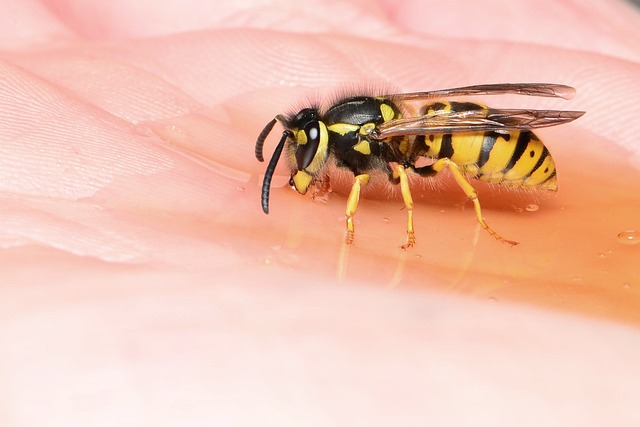Wasps, while beneficial for pollination, can cause problems with nest building and stinging. Traditional chemical pesticides harm the environment and non-target species. Eco-friendly wasp solutions are gaining popularity as they preserve biodiversity and create safer living spaces, especially for allergy sufferers. Advanced technologies like pheromone sensors and remote monitoring systems reduce environmental impact. New treatments include microencapsulated IGRs and genetic techniques to control wasp populations without harming beneficial insects or the environment.
In recent years, advanced technologies have emerged as game-changers in detecting and managing wasps, offering more effective and eco-friendly solutions. This article delves into two critical aspects: understanding wasps’ behaviors and impacts, and exploring modern methods for control. We discuss traditional techniques, their limitations, and present innovative, sustainable approaches. From sophisticated detection technologies to cutting-edge treatment strategies, these advancements promise a greener future in wasp management.
Understanding Wasps: Behavior and Impact
Wasps, despite their importance in pollinating certain plants and controlling other insect populations, can become a nuisance and cause significant damage to homes and gardens when they build nests nearby. Understanding their behavior is crucial for developing effective eco-friendly wasp solutions. These social insects live in colonies with a queen, workers, and males, each playing a distinct role. The workers are responsible for foraging, nest construction, and defense, while the males exist solely to mate with new queens.
The impact of wasps can be severe. They build intricate paper nests that can cause structural damage to buildings over time. Additionally, wasp stings can be painful and potentially dangerous for individuals with allergies. Traditional methods of control often rely on chemical pesticides, but these can have adverse effects on the environment and beneficial insects. Therefore, adopting eco-friendly wasp solutions is not just a preference but an essential step towards preserving biodiversity and creating safer, more sustainable living spaces.
Traditional Wasp Control Methods: Pros and Cons
Traditional methods for wasp control often rely on synthetic pesticides and chemicals, which can have both positive and negative impacts. On one hand, these conventional approaches are effective in quickly eliminating wasp populations. They offer immediate relief from invasive wasps, especially in emergency situations. However, the use of harsh chemicals raises environmental concerns. Many traditional insecticides are non-selective, harming not only targeted wasps but also beneficial insects, birds, and other wildlife. This can disrupt local ecosystems and contribute to broader ecological imbalances.
Moreover, resistance to these chemicals is emerging, rendering them less effective over time. There’s a growing need for alternative, eco-friendly wasp solutions that are both safe and sustainable. These innovative methods include the use of biological controls like parasitoids, which naturally prey on wasps, and the development of non-toxic repellents derived from plants. Adopting these advanced technologies offers a promising path forward in managing wasp populations while minimizing environmental and health risks.
Advanced Eco-Friendly Technologies for Detection
In recent years, advancements in technology have led to the development of innovative and eco-friendly wasp detection methods, offering safer alternatives to traditional pest control. These advanced technologies aim to minimize environmental impact while effectively managing wasp populations. One such method involves the use of sophisticated sensors that can detect pheromones, enabling early identification of wasp nests without the need for physical inspection. This approach reduces the risk of disturbing other wildlife and minimizes chemical exposure.
Additionally, remote monitoring systems equipped with high-resolution cameras provide a non-invasive way to observe wasp behavior and nest locations. These eco-friendly wasp solutions not only aid in prevention but also allow for targeted treatment. By combining these advanced technologies, professionals can implement more sustainable pest management practices, ensuring the well-being of both humans and the environment.
Innovative Treatments and Management Strategies
In the realm of wasp management, innovative treatments and strategies are emerging, offering more effective and environmentally conscious approaches. One prominent development is the adoption of eco-friendly wasp solutions, which prioritize minimizing the impact on non-target organisms and the overall ecosystem. For instance, microencapsulated insect growth regulators (IGRs) mimic natural processes to disrupt wasp life cycles without harming beneficial insects or the environment.
Additionally, genetic techniques are being explored to develop wasp populations resistant to certain treatments, reducing the reliance on chemical interventions. These advancements not only contribute to a more sustainable approach but also enhance the overall efficiency of wasp management. By combining these eco-friendly solutions with targeted applications and habitat manipulation, professionals can effectively control wasp populations while preserving biodiversity.
The integration of advanced technologies in wasp detection and management offers promising eco-friendly wasp solutions. By leveraging innovative tools, from smart sensors to targeted treatments, we can effectively mitigate wasp impacts while minimizing environmental harm. These modern approaches not only provide more precise control but also foster a harmonious coexistence with these essential pollinators and predators. As research continues, we can anticipate even more sophisticated methods, ensuring a safer and more sustainable future for both humans and wasps alike.
